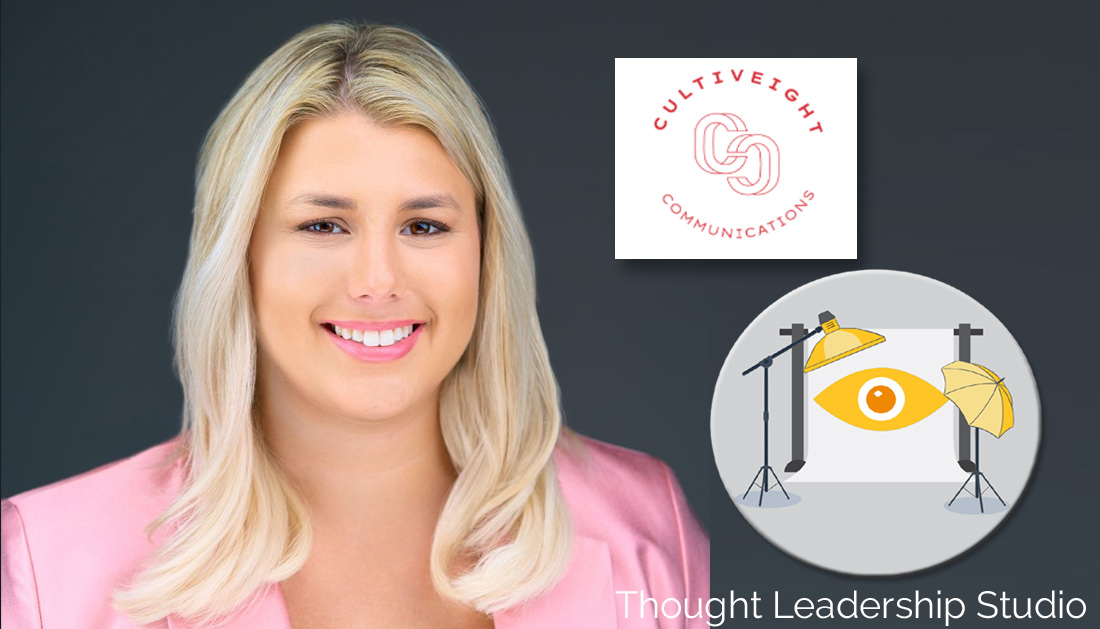Thought Leadership Studio Podcast Episodes:
Elevating Marketing's Role in Business with Caroline Crawford
Episode 73 - Beyond the Campaign: Caroline Crawford's Vision for Strategic Marketing as a Business Partner

#communication, #contentmarketing, #interviews, #marketing, #marketingstrategy, #socialmedia
Or Click here to listen or subscribe on appWhat this episode will do for you
:- Understanding Marketing’s Strategic Importance: Gain insight into how marketing is not just a support function but a strategic partner in business, as Caroline discusses the need for marketing to have a seat at every strategic table.
- Breaking Down Silos in Marketing: Learn from Caroline's experience on how integrating marketing across various business functions can enhance overall business performance and prevent the common pitfalls of siloed operations.
- Effective Use of Channels in B2B Marketing: Understand the importance of selecting the right channels for communication in B2B marketing, and how to effectively engage potential clients through relevant and value-driven content.
- Empathy and Customer-Centric Marketing: Learn why putting yourself in the customer's shoes and approaching marketing from a place of empathy can transform the effectiveness of your marketing strategies.
Caroline Crawford of Cultiveight Communications.
In this episode, I'm excited to introduce Caroline Crawford.
With over a decade of experience in the marketing and communications industry, Caroline has built a reputation as a visionary leader who expertly bridges the gap between strategy and execution. As the founder of Cultiveight Communications, she has pioneered innovative approaches to marketing that emphasize the integration of diverse channels and strategic alignment with business objectives.
Caroline Crawford discusses the critical importance of adopting a high-level view in marketing, ensuring that initiatives are not only well-coordinated but also directly contributing to the overarching goals of the organization. She stresses the necessity for marketing departments to move away from operating in silos and instead work as interconnected units that enhance overall business performance.
Furthermore, Caroline delves into the significance of deeply understanding the customer's perspective. She explains how creating content that truly resonates with the audience can transform a business's engagement strategies.
Join us as Caroline Crawford shares her invaluable insights on transforming marketing into a robust, strategic force that drives business success and fosters lasting customer relationships.
Some of Caroline's coordinates:
Curated Transcript of Interview with Caroline Crawford
The following partial transcript is lightly edited for clarity - the full interview is on audio. Click here to listen.
Chris McNeil: I'm Chris McNeil, with Thought Leadership Studio, and I'm sitting here across Zoom with Caroline Crawford who helps business leaders with aligning marketing initiatives effectively to achieve overarching business goals.
She's a seasoned marketing and communications expert with a 13 year successful track record of blending the Visionary with the integrator, and she's the founder of Cultiveight, which is spelled kind of strange, which I think is cool and specializes in seeing things from a high level in developing and optimizing marketing infrastructure. So with that said, welcome Caroline.
 Caroline Crawford: Thank you so much, Chris. I appreciate everything you just mentioned and I'm excited to be here.
Caroline Crawford: Thank you so much, Chris. I appreciate everything you just mentioned and I'm excited to be here.
Chris McNeil: Yeah, glad to have you here. We love to talk about marketing ...
Caroline Crawford: I can talk all day about it.
From the Weeds to the Skies: Managing Multiple Perspectives in Marketing
Chris McNeil: And it seems like everybody brings something different (to the table), you say "A marketers is a marketer", but, gee whiz, I've met dozens if not hundreds, probably hundreds of marketers, and everybody has a unique perspective they bring to it.
And you mentioned before we started recording, one perspective you take is seeing things from a high level. What do you see from up there up in the sky looking down on these businesses that helps you help them market?
Caroline Crawford: That's such an interesting question. No one's actually ever asked me that. And so when I'm looking at marketing from a high level, I am able to see the weeds. I'm able to understand this is what's happening in the day-to-day, I have a close eye on everything going on, but when I stay at that sort of 10,000 foot view, I'm seeing how everything is all connecting or not connecting.
And a lot of the times marketing is looked at in silos when really it shouldn't be. It needs to all be connected in order for it to be stronger. There are reasons and justifiable reasons why sometimes it needs to be siloed off, particularly for those companies with larger resources where they have the ability to have those kind of operating in silos and still feeling connected.
But marketing is meant to be connected. You don't just do one channel and put all your eggs in that basket. You do email, you do social, you do all these different avenues. And so what I look at when I'm looking at something from a high level is really understanding what's our business objectives, what's our marketing objectives, how we are, all these things that are happening at that street level, if you will, connecting, working towards those objectives. How do we get them to kind of strengthen if they're not operating at the level that we need them to operate?
Chris McNeil: Well, that's a great perspective. We actually had a podcast a couple months ago about systems thinking and marketing and how - as per what just what you just said - is that if you silo off the individual parts of marketing ... and systems thinking says that if you just try to optimize one component of a system, you can improve that component but actually degrade the whole system.
 (Because) You don't look at from a high level of how everything works together. So I think that's a great perspective. And isn't it like how the view from the car stuck in the traffic jam going towards the airport is very different from a view of the plane looking down when the traffic, isn't it?
(Because) You don't look at from a high level of how everything works together. So I think that's a great perspective. And isn't it like how the view from the car stuck in the traffic jam going towards the airport is very different from a view of the plane looking down when the traffic, isn't it?
Caroline Crawford: Yes, 1000% and you can't see it. And I've been in both, I've been at the high level and I've also been in the weeds and many, many times I have to be both at the same time. And what I've learned is that when you're in the weeds, you're just so focused on what's ahead of you. I love that example that you just gave the car heading to the airport, not moving, but then comparing to the airplane where it's like, okay, all you need to focus on, where's my next exit ramp? That's it.
You're only looking a couple miles ahead of you. And so when you are looking at both views simultaneously, you're seeing, okay, what's to come? But then also where, where's their actual destination that we're going and are they on track? And that's where this GPS comes in. And that GPS is really the systems at play, the strategy at play, and all these other components that go into it.
Chris McNeil: Gotcha. So to work this metaphor to death, you want to also make sure you're not on the wrong plane going to the wrong city.
Caroline Crawford: Yes, yes, for sure. And I think again, that's the challenge when it comes to marketing, being working in silos, is that someone on, and I'm just going to use this as an example, someone on the social media team, they're just posting company updates. They're just just getting content out there. But that coming back to our overarching businessing and marketing objectives, that's right.
Outside of just following, how does that connect to what email's trying to accomplish, which is nurturing those people? How is it all connecting? So where one, you're supporting the customer journey, but you're also, again, always going back to what are our sales goals? What are our business objectives?
Chris McNeil: That's really smart. Now I want to loop back to this because that's a really important thread to follow and these overarching objectives that tie things together.
But I want to give our listeners also a little bit of a history for you and how you got into this. What inspired you to get into marketing and to do what you're doing now? Or was there a pivotal point in your life that set you in this direction?
A Marketer's View on Leadership's Misunderstanding of Marketing
Caroline Crawford: Yes and no. I mean, yes, there was in the sense I actually wanted to be in broadcast journalism. I love how things are made, how the things that we find entertaining and see every day are just done. But I learned quickly. I did not want to be a journalist. There are certain aspects to it that I did not want for a career. However, I love the storytelling aspect. I love the angles.
I love making something relevant that wouldn't necessarily be relevant, not just for the sake of it, it has to be genuinely relevant. And I kind of turned to marketing as that sort of avenue. And I was a decent writer, so it's like how can I take my skillsets and the way that I think and view things and apply them? And once I got into that, which was very quick, I never looked back.
I've been in marketing since my first year of college, and I love it. I love every single thing about it. It's always entertaining. However, after at every job that I had in marketing, the problems I experienced were the same. Marketing is a resource that is easily cut from what the budget, it's a resource where not that much budget goes to it. So therefore, and everyone thinks if people don't understand, unless you're a marketer, people think that anyone could do marketing and it's just not the case.
And it's hard to explain that and justify that in all the things. And so that's something I've seen a lot throughout my career when it comes to marketing versus leadership and I use versus intentionally there. And so when it came to what I was witnessing was that, again, there are so many lean resources and anytime I would get the green light to get a little bit extra help, even if it was a temporary solution to something, it was really difficult to find the right support.
 Sometimes it costs an arm and a leg, sometimes it's very rigid scope of work. It made it my job a lot harder as the internal team, all of these different reasons. And then on the flip side, kind of going back to what I said before is the leadership didn't understand marketing. They didn't understand why we needed more resources, why one person just couldn't do it all. And when there's that kind of mindset around marketing, they don't see the true value of marketing.
Sometimes it costs an arm and a leg, sometimes it's very rigid scope of work. It made it my job a lot harder as the internal team, all of these different reasons. And then on the flip side, kind of going back to what I said before is the leadership didn't understand marketing. They didn't understand why we needed more resources, why one person just couldn't do it all. And when there's that kind of mindset around marketing, they don't see the true value of marketing.
And so that's really what I realized when I went from one company towards right before I started my own business, went for one company because I was experiencing those challenges. I had grown as much as I could at that company, and then I moved to a different company and I experienced the exact same problems.
As much as I tried to fix them, I was within this kind of realm of or environment where it just was not fixable due to their inability to actually look at marketing differently. They didn't use marketing as a tool, they didn't see it as a tool. They used it as just a function to support them. And so I started my business to help bridge this gap that exists to shift the mindset that is very common within an organization around marketing, but then also to recognize the challenges that business leaders face when it comes to marketers.
Some of it is justified. Marketing can feel very elusive because people talk about, oh, we can't always tie it back to sales, or it's hard to attribute that or it's taking forever. There's a lot of people who've been burned by marketers, and I'm one of them too. And so was the second pivot point in terms of my marketing career. I never went back. I love marketing, never left it, but my focus for it and my approach to it has evolved.
Chris McNeil: You brought up what I might call limiting beliefs in business leaders about what marketing is and what it can do for you.
What are some of those limiting beliefs about marketing?
The Seat at the Table: Integrating Marketing in Business Strategy
Caroline Crawford: Marketing is meant to have a seat at the table. It's meant to be a business partner. Sales gets invited to the table, product development gets invited to the table, marketing's the last to know about things. So often, this is obviously a generalization. I have some companies who do marketing very well. If I had to guess, they are likely putting marketing at the seat of every single table with all the others.
So they can all work together. They're viewing marketing as an advisor. Because what happens is marketing is an area where, okay, yes, we are sending out an email, putting out a post, we are doing all these things. However, what we're really doing is boiling down what you're trying to accomplish, what you're trying to convey to your audience, the value of what you're offering and all these other necessary things, and boiling it down to where it translates and deeply connects with your audience.
 And we have to do that over and over and over again in different formats so it doesn't feel redundant in different platforms. So we reach different audiences. So we are truly combining a art and a science, but also more so saying to you, Hey, I see what you're trying to accomplish here, but our audience may not understand this, so how can we pull out or approach this in a different way?
And we have to do that over and over and over again in different formats so it doesn't feel redundant in different platforms. So we reach different audiences. So we are truly combining a art and a science, but also more so saying to you, Hey, I see what you're trying to accomplish here, but our audience may not understand this, so how can we pull out or approach this in a different way?
And so when you approach marketing or invite marketing to sit with you early on in these business development conversations or product development conversations, even if they're not right away going, okay, here's our marketing plan and what we're going to communicate, they can gut check you and say, you know what? I think based off of our audience, based off of what we're trying to accomplish and how it's going to be communicated outwardly, this may or may not make sense, or maybe we take this approach or maybe we add this type of thing to enhance the customer experience.
There's a lot of different ways marketing can provide value, but so often people don't see it that way. They see it as, okay, let marketing know. They'll make this pretty, they'll get it out the door, and that's it. And yes, we do that, but it boils it down. It basically kind of dilutes the true value of what marketing can really provide for a company.
Chris McNeil: So part of it is partitioning it off as if it's an afterthought ... and like you said, the silo effect. And I've seen it also, there's this reductionist thinking where, oh, if you're doing enough social posts and hitting the numbers for the number of posts you're doing: "Oh, that's marketing."
Do you think some of that comes from leadership and companies not really seeing their online audience as clearly as maybe people who are already their customers or people in their sales process, but there's also this larger audience that could be paying attention to their medium. They just don't see 'em that way and don't see serving them that way. Maybe the way they do, somebody's already been contacted as a lead and in their sales process. Would that be part of it?
Caroline Crawford: Yeah, I think that's definitely part of it. I think a lot of the times, the way that people view certain channels, for instance, and especially if you're talking about a B2B company, but I think this applies to all types of businesses, is that they see a channel that's very popular. Social media is a great example for this because it's probably one of the top things that people come to me with being like, I want to start social media.
And then I'm like, well, what else are you doing for marketing? They miss all these other channels, and that's what I mean about the siloing, right? Sure. And so when it comes to what you were saying, maybe they don't really value their online audience. I think that yes, that's a big part of it. I think that they don't really understand how each of these different channels support the customer journey, and therefore there's a battle of what's more value, what should we prioritize, what should we put budget in?
Because there are some companies where you really shouldn't have a big budget for social media because that's not really where you're going to get so much of that direct contact with those leads. Not to say it's not valuable, but maybe you should put more effort into content creation and blog creation, something like that.
And so I think that they just aren't seeing the full connection of how all of these components actually influence the customer. Because also too, it's hard if you're not approaching them correctly. If you're a B2B company and you are solely talking about yourself on LinkedIn, for instance, not many people, that's not really going to attract someone as much as you providing value to that audience or to a potential audience. And so I think that's where a lot of disconnect comes in because they don't realize that how they're doing it may be the problem versus the actual place that they're communicating.
Adding Value vs. Self-Promotion on Social Platforms
Chris McNeil: Interesting point you brought up about talking about yourself on LinkedIn versus adding value. Isn't that a really important distinction?
Do most companies that you've experienced already see the benefit of making their content valuable in itself, or they see it more as extending sales or somewhere in between? What do you think?
Caroline Crawford: Yeah, that's a great question. I think that a lot of the times when it's so focused on them, they think that it's a way to build trust and to showcase all that they're doing. The reality is people don't care. They really don't until they really are loyal. And that takes a while.
And so when you see company updates and things like that, it's not to say that that isn't helpful content, or I shouldn't say helpful, that's not the right word, but it's not to say that it's something to completely ignore or never post. Again, its, it has its place. You want to humanize your company, however, no matter what your job is to talk to your customer about them or potential customer about them. And so the more you can talk about yourself in a way that is really talking about your customer is really where the shift happens in marketing.
So a good example is like a case study, how so and so used our platform to went from A to Z essentially, what's their transformation? They either increase their revenue or increase their falling, whatever it was, whatever that case study is that is talking about how you played a significant role in the transformation of someone else who's going through the same journey as the potential client that you're talking to. But I think what happens is a lot of the times it comes off as show-offy.
 It just is more about the company itself, how we built a record amount of X, Y, Z for something while yes, okay, you're still providing a case study, you're still talking about something. You're basically forcing the potential client or whoever's consuming your content to continue reading in order to find out why do they care about it. And I think that's just where there's a big disconnect, is that it's hard to separate yourself and your mind from what that story is and put yourself in the mind of your customer and say, okay. And sometimes you could talk about the same thing and it's just how you present the information that makes it differently. So case studies are a great example for that.
It just is more about the company itself, how we built a record amount of X, Y, Z for something while yes, okay, you're still providing a case study, you're still talking about something. You're basically forcing the potential client or whoever's consuming your content to continue reading in order to find out why do they care about it. And I think that's just where there's a big disconnect, is that it's hard to separate yourself and your mind from what that story is and put yourself in the mind of your customer and say, okay. And sometimes you could talk about the same thing and it's just how you present the information that makes it differently. So case studies are a great example for that.
Chris McNeil: One question that might be helpful - and what's your opinion on this? - is step into the customer's shoes, look at your business from there and ask (through the media), so what does this mean to me? What does this do for me?
Caroline Crawford: Yes, 100%. How can you make their lives easier, better, faster, enhanced? Essentially people buy because they think whatever that you are selling is going to get me to the next step or closer to the next step that I want to be in.
Chris McNeil: So it's about empathy, isn't it? Knowing your customer and caring about, hey, we're not just here to try to target them so much as empower them.
Caroline Crawford: Yeah, I love that you use that. It's absolutely empathy. 100%. You have to put yourself in someone else's shoes. You have to understand why they may be thinking a certain way, what their struggles are, what their hesitations are in the buying process too. For instance, for me with marketing, I'm selling marketing to people who have been burned by marketers.
A lot of the times I'm getting people who are like, I've tried everything and I don't know where to go. I have to make sure that no matter what, I'm understanding where they're coming from and what their hesitations are. Not to manipulate them of course, but to truly understand, okay, are you ready for this? Are we an ideal fit together? Will this actually get you closer to really where you want to be?
And is this the true solution for you? And I think the way marketing does that in general when it's leveraged correctly, is that it understands deeply the customer pain points and why your product or service exists in the world. And it understands that so deeply that it can convey and translate in so many different ways that the audience can then connect with.
***************************************
The transcript is lightly edited for clarity and is a partial transcript- the full interview is on audio. Click here to listen.
***************************************
Free Stuff and Offers Mentioned in Podcast
***************************************
***************************************